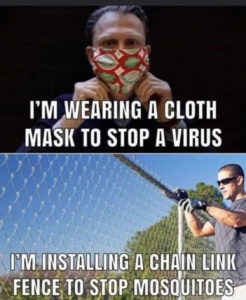Memebusting: Masks, Mosquitoes, and Chain Link Fences
I’ve seen this meme a lot on Facebook, and wanted to take a little time to swat it.
I get why this one is popular among people who don’t believe masks are effective. The comparison is funny enough to be catchy, and the logic is plausible. Viruses are really, really tiny — that’s high school science. The COVID-19 virus is only 125 nanometers.
So it’s fair to ask how cloth masks are supposed to stop COVID-19.
The first thing the meme fails to recognize is that the virus isn’t traveling solo.
“Current evidence suggests that COVID-19 spreads between people through direct, indirect (through contaminated objects or surfaces), or close contact with infected people via mouth and nose secretions. These include saliva, respiratory secretions or secretion droplets. These are released from the mouth or nose when an infected person coughs, sneezes, speaks or sings, for example. People who are in close contact (within 1 meter) with an infected person can catch COVID-19 when those infectious droplets get into their mouth, nose or eyes.” (Source; emphasis added)
The mask’s primary goal isn’t to stop individual virus particles; it’s to stop the droplets the virus is traveling in. Those respiratory droplets are 5-10 micrometers in diameter. That’s between 40 and 80 times larger than the virus itself.
(For comparison, mosquitoes average about 0.4″. Now imagine a mosquito two feet long. Or don’t — the last thing we want to do is give 2020 more ideas…)
Going back to the chain link fence, it’s not that we have individual normal-sized mosquitoes trying to fly through. (Viruses generally don’t have wings!) Instead, our wingless COVID mosquitoes are hitching rides in respiratory water balloons.
That’s what masks help to block. Just like a water balloon has a hard time getting through the fence, those respiratory droplets have a hard time getting through a mask.
The primary benefit here is to protect others. COVID-19 is highly contagious, and people can be infected without realizing (pre-symptomatic or asymptomatic). Wearing a mask reduces the chance of your droplets infecting other people.
Nature has one of many studies showing the effectiveness of masks in reducing viral transmission.
The mask can also help reduce your chance of inhaling other people’s droplets. And of course, the mask can serve as a reminder to avoid touching your face and to take other precautions, like hand-washing/sanitizing.
Are masks perfect? Of course not. And it’s true that some types are more or less effective than others. But a “less effective” mask is still a heck of a lot more protection than nothing at all. Two sick hairstylists in Springfield wore cloth masks while interacting with 140+ customers, all of whom were also required to wear masks. None of the customers caught COVID-19.
I understand some people don’t want to wear them. I get it — I don’t like wearing them either. But a large body of scientific evidence shows that they do work. So wear the damn masks. You could be saving someone’s life.







Deborah Makarios
July 14, 2020 @ 6:57 pm
The meme would make a lot more sense if it was having a go at mesh masks, which, while technically masks, don’t actually act as a barrier to anything smaller than, say, a carrot stick.
Rie Sheridan Rose
July 15, 2020 @ 12:14 pm
Great post, Jim.
HelenS
July 16, 2020 @ 5:04 pm
I like pointing out that most umbrellas are made of woven fabric that has spaces between the threads that are a lot bigger than water molecules, too. Doesn’t mean they don’t keep any rain off.
Deborah Blake
July 17, 2020 @ 9:27 pm
Great point, HelenS!
TheSFReader
July 24, 2020 @ 4:47 am
One misleading thing too, in the mosquito/chain link fence comparison, is that the mosquito has intention/instinct to reach through the chain link and the mean to effect its trajectory, which is NOT the case for covid19 in particles. So while the mosquito would get multiple tries to go where it wants, once in contact with the mask, the droplet doesn’t get a second chance. it sticks to it, and that’s all.
Not to mention that the mask restricts air speed (not flow since the mask LETS air pass trrough), reducing spread radius/distance, while the chain link fence doesn’t do much WRT air speed.
TwoScienceDegrees
August 15, 2020 @ 1:41 am
That your mask isn’t soaked at the end of the day is proof that the water droplets evaporate, leaving the virus particles to pass through unimpeded. Also, most of your breath does not pass through the mask, but around it.